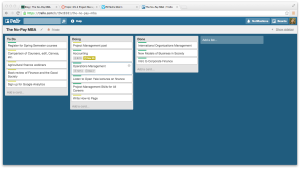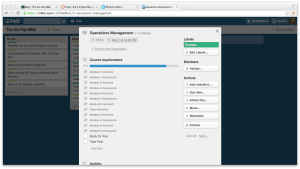by Laurie Pickard | Nov 24, 2013 | Courses, Platforms, and Profs
As first semester comes to a close, I will soon be enrolled in only one course. New Models of Business in Society ended a while back, International Organizations Management also wrapped up several weeks ago, and I’m preparing for finals in my two Wharton courses – Operations Management and Accounting. Until Spring Semester starts, my only course will be Project Management Skills for All Careers, through Canvas Network. It’s good timing for a lightened course load, since I just started a new job – hooray! (More on that in a future post.)
Project management is kind of my thing. Even though I haven’t studied it formally until now, project management is the bread and butter of my professional life. I am the type of person who gets truly excited about a well-designed spreadsheet, and creating a color-coded calendar is the type of thing I might do for fun, so I was a bit skeptical that this intro course geared towards accidental project managers would have anything to offer me.
I’m pleasantly surprised that already in the first two modules of my Canvas course we have covered some material that I have found interesting and enlightening.
The Difference Between Project Management and Operations Management
First, I was pleased to get a definition for project management as opposed to other kinds of management. To paraphrase from the textbook we are using for the course - a digital book with the same name as the course itself:
A project is temporary in nature and geared towards producing a unique outcome. It ends once it has met its goals and objectives or is cancelled if those goals and objectives cannot be met.
Managing a project is quite different from managing an ongoing process. The latter was the topic of my course in Operations Management, which was geared towards finding efficiencies in processes that are repeated again and again, over an indefinite period of time. In contrast, a project happens only once, so much of it is created new and is specific to the task at hand.
The Three Pillars of Project Management
Second, the course offered a helpful set of key considerations in any project, which are referred to as the three pillars of project management. These are:
- Cost,
- Schedule, and
- Scope/quality.
Inherent tradeoffs exist among these three pillars, as exemplified in this sign that was printed in our textbook, said to have come from an auto repair shop:
We do GOOD, CHEAP, and QUICK work.
You can have any two but not all three.
GOOD QUICK work won’t be CHEAP.
GOOD CHEAP work won’t be QUICK.
QUICK CHEAP work won’t be GOOD.
Visual Project Management
Third, and best of all, the course jumped right into practical techniques for managing projects. The method they started with is called visual project management. Imagine a white board with cards that represent tasks that must be completed as part of the project. The cards are organized into three columns: To Do, Doing, and Done. Several free web-based software programs offer virtual whiteboards and cards. I have started using one called Trello, and I am absolutely in love with it.
Here, you can see how I am organizing the No-Pay MBA. Cards with a green label are for courses, and those with a yellow label are for blog-related items.

If you click on any of these cards, the back of the card offers many other tools including checklists, deadlines, color-coded labels, email notifications, etc.

I’m excited to see where Project Management for All Careers goes next, but even if I don’t get anything else out of the course, I’ve gotten my money’s worth – and I’d feel the same even if the course weren’t free.
by Laurie Pickard | Oct 31, 2013 | Courses, Platforms, and Profs, Thoughts on Higher Ed and Life
My most disappointing course this semester was International Organizations Management. I chose the course because I work in this field and was curious what the instructors would present. The course was taught by a group of professors from the University of Geneva, all of whom are on the faculty of that university’s international MBA program. As I’ve mentioned previously, most of the jobs in international development, and I would imagine in international organizations more generally, are management jobs. However, our training is mostly theoretical, so one must learn the practical skills of management while on the job. I was hoping that this class would cover some of these skills, especially since the recommended background for the course was “Graduate students of international relations/business management/international law and/or professionals with a few years of relevant work experience.”
I was sorely disappointed – yet another class longer on theory than practice.
I was hoping for best practices related to the work that I do, for example:
- Managing a project budget
- Conducting and participating in meetings
- Creating a work plan and project timeline
- Crafting a monitoring and evaluation plan, including setting targets and choosing indicators
- How to design a public private partnership (the course did touch on this, but didn’t get into specifics)
Alas, what I got instead was more an overview and history of the UN system than any practical tools for operating in the international arena (in which, incidentally, the UN is only one player, and not necessarily the most important player at that!).
Interestingly, the one module of the course that I really enjoyed was the one on marketing, not a topic in which I had any prior interest. What I liked about the module was that it spoke about particular techniques for making a marketing plan, including specific questions that an organization needs to answer in order to make a strong plan. The course also made me realize that I have had the wrong understanding of marketing, probably because most international organizations approach marketing as though it were of secondary importance – an afterthought.
The following graphic shows the place of marketing in most international organizations.
Marketing falls below communications, which itself is a third-tier category. Contrast that with the position of marketing in the private sector.
In a private sector company, marketing is directly under the CEO and is responsible not just for PR and promotion but is integrally involved with crafting the overall strategy for the company and in building its identity.
Even though I didn’t learn much in International Organizations Management that I can apply on the job, I did benefit from the course in that it piqued my interest in marketing - one of the topics for next semester. So in the end, I’m glad I stuck it out.
by Laurie Pickard | Oct 24, 2013 | Courses, Platforms, and Profs, Thoughts on Higher Ed and Life
Operations Management is one of those classes that causes you to see your whole world differently. The class is more conceptual than mathematical – though there is some math involved – and we’ve covered such concepts as The 4 Dimensions of Performance, The Bottleneck in a Production Line, Inventory Turns, Throughput, and Capacity. Now I’m looking at every multi-step process in my life with new eyes. I even found The Seven Sources of Waste – and hence the opportunities for improved efficiency – in the Indian vegetable curry and garlic naan I made for dinner yesterday evening.
- Overproduction. There are only two of us, but my naan recipe produced 12 fluffy pieces of bread.
- Transportation. The spice packet I used to flavor my curry was produced in India. I purchased it in St. Louis, MO and packed it in my shipment to Rwanda, where my husband and I are stationed. Talk about transportation! If only I could find Indian spice packets locally.
- Re-work. My inexperienced hands took multiple attempts to form round naan. In the end, they were still uneven – but delicious.
- Over-processing. I budgeted too much time for the curry, and too little for the bread, so the curry ended up cooking longer than it needed to. No effect on the taste, but a small amount of wasted electricity.
- Unnecessary motion. Why are cutting boards always too small? Seems like I’m constantly going back and forth between the cutting board and the pot on the stove.
- Inventory. All those chopped veggies ready to go into the pot. In Operations Management, “inventory” is the item that is going through the process – in this case vegetables going through a process of becoming curry.
- Waiting– for the web page with the recipe to load. Could Rwanda’s internet be any slower?
by Laurie Pickard | Oct 15, 2013 | Courses, Platforms, and Profs, MOOC MBA Design
I recently finished my first Coursera course and received a Statement of Accomplishment. The Statement of Accomplishment is Coursera’s answer to my question in a previous post. For some of my courses students are invited to pay for a “Verified Statement of Accomplishment” by joining a “signature track” for the course. The coursework is the same, but only the paying students get the verified statement at the end. I respect Coursera’s efforts at bringing legitimacy to free coursework, but I don’t place a lot of value on the Statement of Accomplishment, primarily because the level of difficulty is highly variable from course to course. The class for which I received my first Statement of Accomplishment was interesting, but incredibly easy. I listened to the lectures each week, but I could have answered each week’s five-question quiz correctly without having done so. In contrast, last week I spent a couple of hours on the homework for my Intro to Operations Management course and had to re-watch a couple of the video lectures.
Of course, some of my college classes were pretty easy too. I once took a class called “Geology of the National Parks,” which I and the entire football team were using for our science requirement. I also got credit for an elective swimming class. But my overall degree program is what ended up counting - no employer has ever asked to see the titles (or my grades, for that matter) of individual courses.
The Statement of Accomplishment is a good start, but I would like to see Coursera (and others) offer something closer to a degree - a Statement of Accomplishment that covers multiple courses and recognizes the totality of study. If such a thing were available I might even be willing to spend a few bucks to get one.
by Laurie Pickard | Oct 9, 2013 | Courses, Platforms, and Profs, Thoughts on Higher Ed and Life
My Intro to Accounting professor recently posted some demographic information from the course pre-enrollment survey. I find this data very interesting, so I’m sharing the highlights here.
|
Students enrolled:
|
127,569
|
|
Active students:
|
91,865
|
|
Number of students submitting homework:
|
28,951
|
|
Total discussion forum posts:
|
5,694
|
|
Number of students posting:
|
2,876
|
First, check out the number of students enrolled. Wow! Over 120,000 students. This course is really putting the MASSIVE into Massive Online Open Course. And of those, almost 92,000 are active – meaning that they are participating in the course in some form. Those roughly 29,000 submitting the homework are the ones I consider to be taking the course seriously – as previously mentioned, most people who sign up for MOOCs don’t finish them, or don’t participate fully.
Notice how many students are posting on the discussion boards. Around 3,000, with roughly two posts per person. My main frustration with online courses so far is how overwhelming the discussion boards are. I registered for emails from the International Study Group board, and my inbox was flooded. In this class, only a small fraction of the students are participating in the discussions, and it’s still totally swamped with comments.
|
Male:
|
|
54%
|
|
First MOOC:
|
|
53%
|
Roughly evenly divided male/female. And about half having previously enrolled in a MOOC.
Ages of students:
|
21 and under:
|
|
7%
|
|
22 – 30:
|
|
39%
|
|
31 – 40:
|
|
27%
|
|
41 – 50:
|
|
16%
|
|
51 – 60:
|
|
9%
|
|
61 and over:
|
|
4% (including 8 students over 90!)
|
I’m not sure I believe that there are 8 students over age 90 – that seems like a joke to me – but hey, it’s possible. Besides those 90-year-olds, it’s no surprise that the people taking these courses are generally post-college age. Since this method of education doesn’t have the same legitimacy as traditional university studies (yet), it makes sense that most people in the college age bracket who want to take college classes would be doing it at a regular college. The table below paints a similar picture.
Highest level of education
|
High school or below:
|
|
6%
|
|
College up to Bachelors’ Degree:
|
|
13%
|
|
Bachelors’ Degree:
|
|
44%
|
|
Masters’ or Professional Degree:
|
|
35%
|
|
PhD:
|
|
3%
|
I wonder if these numbers reflect the type of course; since accounting has such obvious real-world applications, it may be that more people who have already gone to college or graduate school are interested in picking up these skills, versus – I don’t know – Intro to English Literature.
Now here’s where it really gets interesting.
|
Number of Countries Represented:
|
|
188
|
Holy smokes! There are only about 190 countries in the world! (Plus or minus a few depending on how you count.) That means that almost every country in the world has a representative in this class. I wonder if there are others besides me who are taking the course from Rwanda.
Top Ten Countries
|
United States:
|
|
38%
|
|
India:
|
|
8%
|
|
Canada:
|
|
4%
|
|
Philippines:
|
|
2%
|
|
Spain :
|
|
2%
|
|
Australia:
|
|
2%
|
|
Russia:
|
|
2%
|
|
United Kingdom:
|
|
2%
|
|
Brazil:
|
|
2%
|
|
China:
|
|
2%
|
Yes, the plurality of students in the class are from the US, but it isn’t a majority. These stats on the international composition of the class highlight for me how useful MOOCs can be for students who don’t have access to an American university education.
by Laurie Pickard | Oct 5, 2013 | Courses, Platforms, and Profs
My favorite course this semester – surprisingly – is Intro to Accounting. Accounting - and accountants - have a reputation for being terribly dull, and even the professor apologizes frequently for the dryness of the material. But I am positively loving it. Tracking accounts feels like one long logic puzzle, and I love logic puzzles. I also appreciate that the course gives specifics on how to do a particular job. I am learning how to put together the four financial statements that all accountants are responsible for creating, and how to do so in accordance with the standards of the profession.
In fact, what excites me about the MBA overall is that it is professional training, with direct on-the-job applications. My field – international development – doesn’t have a single professional degree. Most of us have master’s degrees, but in a variety of different fields. I studied geography, which gave me a solid understanding of the global context in which development occurs and some analytical tools for understanding why one place is different from another. I also learned how to write, how to do social science research, and how to think about development issues – all very useful. But understanding the context in which I perform my work is not actually the same as knowing how to do my work.
Much of the work in international development falls broadly into the category of Project Management. But my academic training didn’t include any coursework involving practical elements of managing development projects. None of my graduate or undergraduate courses dealt with the kind of questions that came up within the first week of having an office job in a development organization, for example:
What is the best way to design a budget spreadsheet?
How do you avoid circulating and saving multiple versions of the same document?
Is it possible to conduct a meeting that doesn’t waste everyone’s time?
What are TORs and how do you write them?
Intro to Accounting is skills-based, as opposed to knowledge-based. Which is to say that at the end of the course not only will there be new information that I KNOW but also new things that I can DO.
These are called T-accounts, and I know how to make them!










